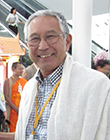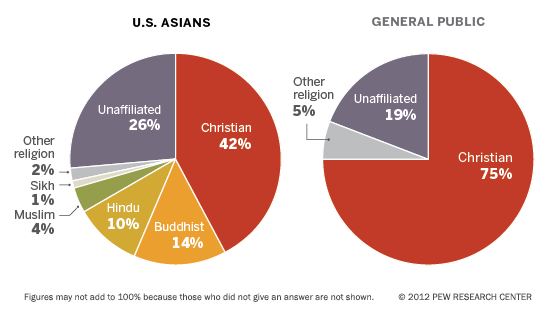On Learning and Teaching the Art of Sho
When offering a course on Buddhist art and aesthetics at the Graduate Theological Union, I always include a session on the art of sho (calligraphy), a major genre in East Asian culture that is still practiced among the Chinese, Japanese, and Koreans in the United States. The three-hour session begins with a brief introduction to the history of calligraphy, the varieties of brush, paper, and ink, and most importantly, the pedagogical strategy of transmitting the art and aesthetics of line and space that are employed to write Chinese ideograms and Korean and Japanese syllabary. The remainder of the class is devoted to demonstrating select aesthetic qualities present in different Chinese and Japanese calligraphy samples. Subsequently, students are given the opportunity to hold the brush and write characters and syllabic forms. Lines and space formed by a soft brush cannot be appreciated unless one experiences the use of the soft brush. Earlier classes will have introduced the philosophical underpinnings of Zen Buddhist thought that much of the current vocabulary in the art of sho uses. Except for the occasional art student, most have no prior familiarity with the soft brush. The exercise quickens an immediate appreciation for the difficulty of controlling the free-flowing ink and the pliant brush. This difficulty also leads to an intuitive realization that the art of sho is a discipline that is honed by years of practice.
The Art of Sho
While in Kyoto, Japan, I studied with the avant-garde sho-artist Morita Shiryū (1912–1998). During one of our many conversations he said, “I look forward to growing old.”
“But, why?” I asked incredulously.
“I want to see how my art will mature and change.”
I was twenty-six at the time; Morita was fifty-eight. This “teaching moment” has since guided my own intellectual and aesthetic explorations and teaching. In retrospect, my sensei, "teacher," who had established an international reputation, was intensely exploring his art as a vehicle to deepen and give form to his kyōgai, 境 涯, or “spiritual dwelling place.” Ordinarily, kyōgai refers to one’s socioeconomic status, but in Japanese Buddhist culture, the expression refers to a spiritual and aesthetic quality that is nurtured through long and thoughtful experience of being in the world. A person with profound kyōgai is at ease with him or herself and lives and relates to the world and others with equanimity and integrity.
The art of sho, 書, has a long history. From its beginnings in China, it spread to Korea, Japan, Vietnam, Manchuria, and other regions that came under the influence of Chinese civilization. Sho (as it is referred to in Japan) or “writing,” is the simple exercise of writing characters or ideograms—the Korean hangeul, and Japanese kana. Aesthetic and creative interests lead the sho-artist to explore ideographic styles and developments, to give expressive shape to their meanings, to “play” with their constructions (form and stroke order), to explore the potential and limitations of the brush and the textures of ink and paper, and to give form to feelings and thoughts.
The art of sho can be properly called abstract art; it is nonfigurative, nonobjective, and nonrepresentational. The ideograms the sho-artist writes evolved from inscriptions scratched on bones and turtle shells that expressed yearnings for a good harvest and aspirations for health and safe passage through life. The ideographs are abstractions of objects, sounds, and ideas. While they may have originally been inspired by images found in the natural world, the characters are most often far removed from the natural or objective world.
The Study of Sho
.jpg) 慈 “Ji”: “feeling,” “benevolence,” by Ronald Y. Nakasone. 2013, 10 ¼" x 14 ⅜".
慈 “Ji”: “feeling,” “benevolence,” by Ronald Y. Nakasone. 2013, 10 ¼" x 14 ⅜".The student turns to samples of sho masterpieces for instruction and inspiration. This traditional method of study is rinsho, 臨書—"seeing," 臨, and "writing," 書. “Seeing” involves knowing and understanding. “Writing” means to execute with the soft brush what is known and understood. The intent of this pedagogical method is for the student to discover the movements of the brush (i.e., to understand how lines and characters are executed and to replicate its operation). Through repeated “seeing” and “writing,” the student discerns the changes in the line that appears, from the subtle variation in the movement and pressure of the brush, the texture of ink, and character of the writing surfaces. Normally, the student studies masterly executed samples of sho that exhibit technical skill and innovation. But with practice, the student can eventually “see” how lines are executed and replicate them.
More importantly, the exercise of rinsho is intended to peer into the mind and being of the writer. The student approaches a masterpiece seeking to know: Who is this person that has mastered the brush? What was their state of mind/being at the moment of creation? By entering into the mind and being of master calligraphers, the student intuits that calligrapher’s being and understands their place in the history and the art of sho.
Line (Form) and Space
Lines are everywhere. Seen from afar, my arm is a line; the brush I hold is a line; a plastic pipe is an uninteresting line. The edge of the blackboard is a line. Some lines are harsh and cold; others are soft and fluid; others are dynamic, bold, and rhythmic. Still others display strength, vigor, steadfastness, profundity, and playfulness. A single brush can produce these and other aesthetic elements. Shipinggongzaoji, 始平公造像記 (Jpn Shiheikozōzōki, 498 CE), offers prime examples of hard incisive lines. The lines of Jianzhonggaoshentie, 健中告身帖 (Jpn Kenchū kokushin chō), by Yanzhenqing, 願真柳 (Jpn Ganshinkei, 709–785), are warm, subtle, and fluid. The lines of Fujiwara Yukinari, 藤原行成 (9721–1027), that form Hakuraku tenshi kan demonstrate a technical mastery that explores the rhythmic possibilities of the brush. Samples by the 18th century Sōtō Zen cleric Ryōkan, 良寛 (1758–1831), exhibit a disciplined playfulness.
Space, an essential aesthetic quality, is difficult to appreciate and understand for those trained to see and create with line, form, and color. The reciprocity and inseparability between space and line highlight the interplay of black form and white space. Space is not a passive medium in which forms are located or where events occur, rather it defines and is the source from which form emerges. Form in turn creates space that gives meaning and efficacy to form. “Samples” of “space” are especially strong in Ryōkan’s Eki etsu, 易曰, from the Kimura Collection.
In the art of sho, the space the artist creates when the ink-laden brush moves across the writing surface is also an existential statement. It is an aesthetic quality that reveals the “spaceless” abode of the writer-artist’s kyōgai, a quality most appreciated in the sho of the Rinzai Zen master Hakuin Ekaku (1685–1768). Hakuin first revealed his profound kyōgai after the age of 60, but it was not until he entered his ninth decade that his sho revealed a rarefied spiritual landscape. Lines of direct and unfettered simplicity reveal nothing special, no particular beauty, only an uncommon ease that transcends our understanding of space and time.
The pliant brush, free-flowing ink, and absorbent paper are the ideal tools to give form to those moments when the sho-artist, dwelling in creative mindfulness, issues forth the contours of their spiritual landscape. This landscape is not a fixed experience or an absolute or metaphysical reality; it is the expressive insight of a singular moment in time and place (space). The line and space that appears give form to the sho-artist’s formless self and spaceless intuition of an ever-changing subjective reality.
Teaching and Learning the Art of Sho
The pedagogy of teaching and learning the art of sho is in many ways an anachronism, meant for a different age; but it offers an insight into the traditional arts of Japan. In addition to the technical elements of writing characters, the study of sho introduces a traditional method of transmitting knowledge and skills in which the teacher is expected to also pass on wisdom and a life style.
After readying the ink, paper, brush, and the writing surface, I demonstrate my own exercise of rinsho, "seeing and writing." I usually begin with the character 石 from Shipinggongzaoji, because it exhibits the brilliant execution of horizontal, diagonal, and vertical movements of the brush. I draw inspiration from the great control of the advancing movement of the brush; I move the brush with attentive deliberation. In the same spirit, I turn to 行 and other characters from the Jianzhonggaoshentie. Yanzhenqing’s lines are superb examples of the pressing and lifting of the brush that produce warm and supple lines. Students take turns “seeing” and “writing.” Through the experience of writing, students enter into a living tradition through its traditional pedagogy. Because the use of the brush requires total concentration, students appreciate the need for complete focus on the task. Once the student masters the operation of the brush and makes its spirit their own, traditional forms are effortlessly broken/transcended.
Teaching and learning the art of sho serves as a useful reminder that forms are expressions of human yearnings, aspirations, and beliefs. Similarly, the focus of “religious studies”—texts, doctrines, history, and art—are intellectual expressions of subjective and intensely “religious” and “spiritual” sentiments and experiences. Rinsho is a most appropriate pedagogy for the discipline of art and religion that requires an analytical examination of forms, and an appreciation for religious and spiritual sentiments that animate form. For Asian Americans, the art of sho is a portal into a shared cultural and aesthetic tradition that is unique to East Asia.
Early on November 3, 1998, I visited my sensei for the last time. I last saw him the year before; he had grown frail. We proceeded to Shizukaryō, a nearby ryōkan (Japanese-style inn) on the edge of Lake Biwa, where he was having an informal retrospective. After a leisurely lunch, we toured the second floor exhibit, exchanging reflections on the subtle details of space, form, and formless-form. His latest works revealed a quiet ease; the energetic lines of youth had given way to serene spacelessness. He mentioned that he would like to celebrate his beiju (eighty-eighth year, a major milestone for a Japanese elder) with a major exhibit in Tokyo. I wondered: What forms would his kyōgai inspire? What kind of space would be issuing forth from his brush? Three weeks later, his karmic energy spent, my sensei passed into the great ocean of birth and death.
 Ronald Y. Nakasone, PhD, is heir to the age-old East Asian literati tradition that encourages self-cultivation, self-transformation, and self-realization through scholarship, community involvement, and art. He has exhibited in Kyoto, Tokyo, Paris, Seoul, Xian, Chiang Mai, and cities throughout the United States. A member of the core doctoral faculty at the Graduate Theological Union (GTU) and a consultant at the Stanford University Geriatric Education Center, Professor Nakasone has published more than one hundred academic books and articles on Buddhist doctrine, ethics, and aesthetics, aging and spirituality, and Ryūkyūan studies. He received the Sarlo Excellence in Teaching Award from the GTU in 2011.
Ronald Y. Nakasone, PhD, is heir to the age-old East Asian literati tradition that encourages self-cultivation, self-transformation, and self-realization through scholarship, community involvement, and art. He has exhibited in Kyoto, Tokyo, Paris, Seoul, Xian, Chiang Mai, and cities throughout the United States. A member of the core doctoral faculty at the Graduate Theological Union (GTU) and a consultant at the Stanford University Geriatric Education Center, Professor Nakasone has published more than one hundred academic books and articles on Buddhist doctrine, ethics, and aesthetics, aging and spirituality, and Ryūkyūan studies. He received the Sarlo Excellence in Teaching Award from the GTU in 2011.

